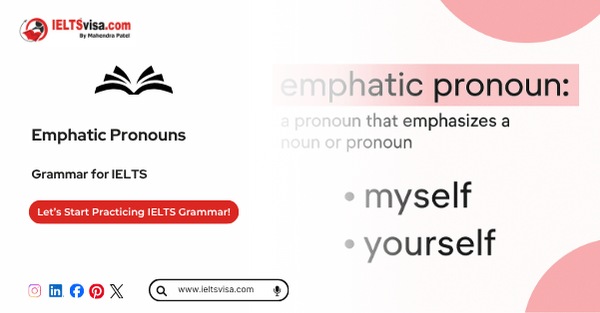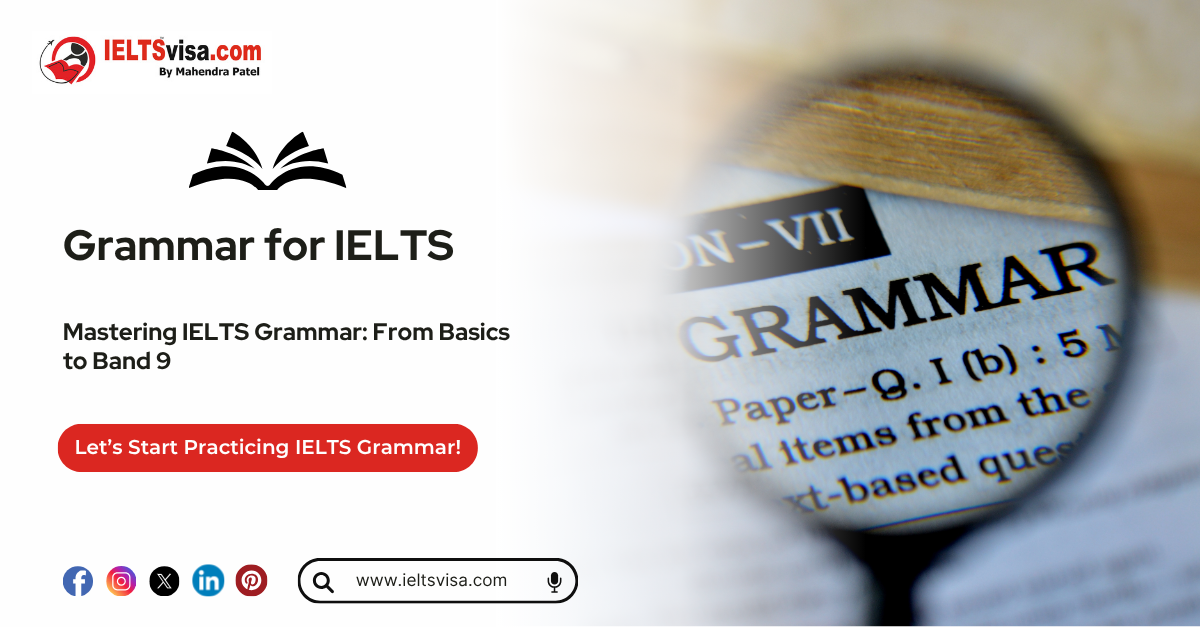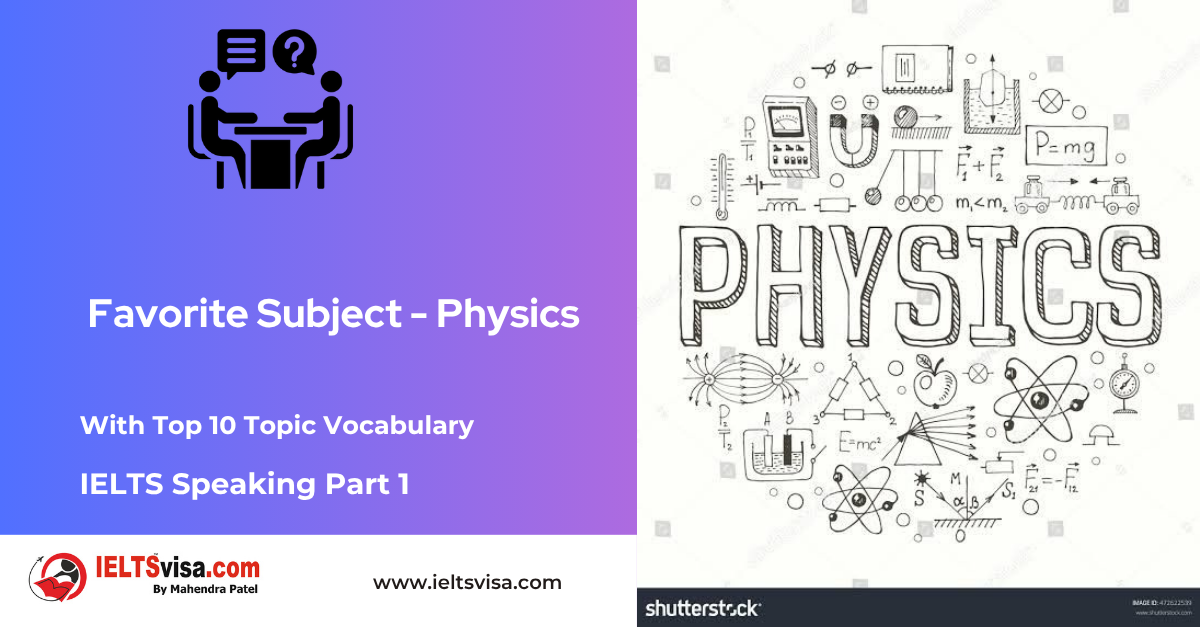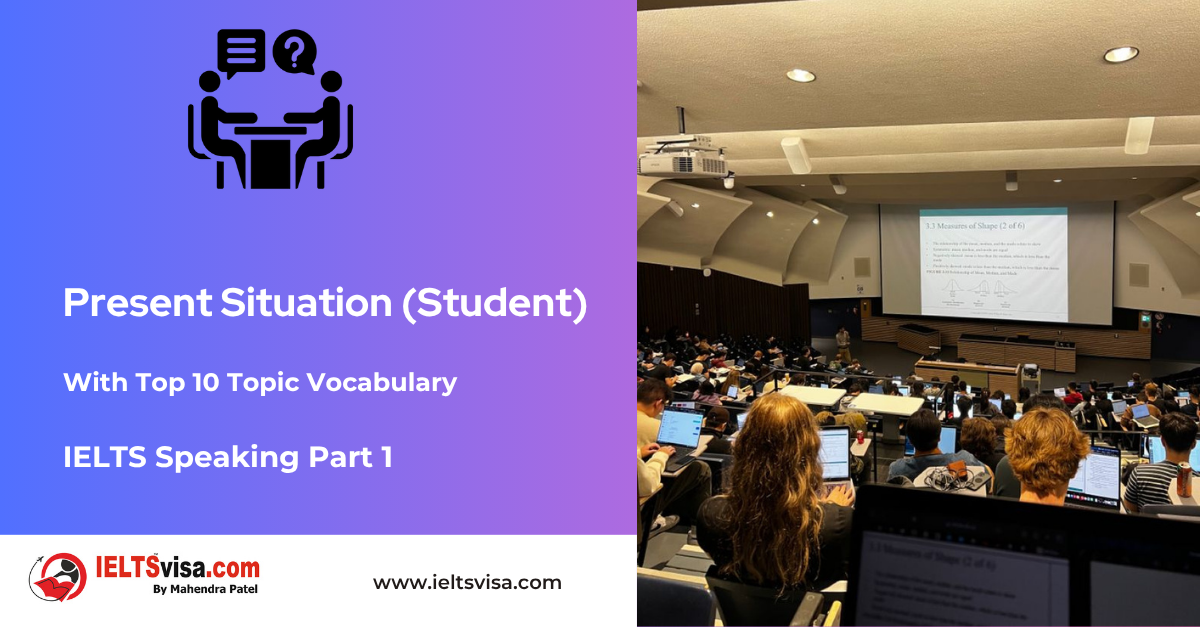Emphatic Pronouns
Grammar for IELTS

Emphatic Pronouns: Definition, Usage, and Examples
Pronouns are essential tools in English grammar, allowing us to make our sentences more concise and engaging. Among the various types of pronouns, emphatic pronouns play a special role by emphasising the subject or object of a sentence. If you’re learning English or want to strengthen your grammatical foundation, this guide will help you understand emphatic pronouns, how they differ from reflexive pronouns, and how to use them effectively.
Table of Contents
1. What Is an Emphatic Pronoun? – Meaning and Definition
2. How to Use an Emphatic Pronoun in a Sentence
3. Difference Between Emphatic Pronouns and Reflexive Pronouns
4. Examples of Emphatic Pronouns
5. Test Your Understanding of Emphatic Pronouns
6. Frequently Asked Questions on Emphatic Pronouns
What Is an Emphatic Pronoun? – Meaning and Definition
An emphatic pronoun is used to emphasise a noun or pronoun in a sentence. Words such as myself, yourself, herself, himself, itself, ourselves, yourselves and themselves are examples of emphatic pronouns. These pronouns appear immediately after the noun or pronoun they emphasise, thereby adding emphasis to the subject or object of the sentence.
Definition:
According to the Oxford Guide to English Grammar, an emphatic pronoun is “a pronoun such as ‘myself’ or ‘themselves’ that emphasises a noun phrase, for example, ‘The artist herself painted the masterpiece.’”
How to Use an Emphatic Pronoun in a Sentence
Emphatic pronouns are usually placed right after the noun or pronoun they emphasise. Their removal from the sentence would not change its grammatical correctness but would reduce the emphasis on the noun or pronoun.
Examples:
1. The president himself visited the disaster-stricken area.
2. I myself completed the entire project without any assistance.
3. They themselves admitted their mistake.
In these sentences, emphatic pronouns add a layer of importance, highlighting that the action was performed personally or without external help.
Key Rule:
While emphatic pronouns add emphasis, they should not replace other pronouns such as “me,” “him,” or “her.”
Difference Between Emphatic Pronouns and Reflexive Pronouns
Though emphatic pronouns and reflexive pronouns use the same words, they serve different purposes. Here’s a quick comparison:
Emphatic pronouns and reflexive pronouns are both formed using the same set of words, such as myself, yourself, himself, herself, itself, ourselves, yourselves, and themselves. However, their functions in a sentence differ significantly. Here’s a detailed comparison presented in a table for easy understanding:
|
Aspect |
Emphatic Pronouns |
Reflexive Pronouns |
|
Definition |
Used to emphasise a noun or pronoun in a sentence. |
Reflects back to the subject performing the action in the sentence. |
|
Purpose |
Highlights or stresses the role of the subject or object in a sentence. |
Indicates that the subject and the object are the same entity. |
|
Position in the Sentence |
Usually follows the noun or pronoun it emphasises. |
Often used after the verb as the object or to complete the meaning. |
|
Effect on Sentence |
Can be removed without changing the basic meaning of the sentence. |
Cannot be removed; it is essential for the sentence’s meaning. |
|
Example Sentence |
– She herself made the arrangements. |
– He made dinner for himself. |
|
Grammatical Role |
Adds emphasis to the subject or object. |
Acts as the object of the sentence, reflecting the subject. |
|
Emphasis |
Explicitly provides emphasis or stress. |
No explicit emphasis; focuses on self-reference. |
|
Verb Compatibility |
Works with transitive and intransitive verbs, depending on placement. |
Typically works with transitive verbs that require an object. |
|
Alternate Usage |
Often used to add dramatic or stylistic effect in speech or writing. |
Used to clarify actions done by the subject without outside influence. |
|
Emphatic Pronoun |
Reflexive Pronoun |
|
Used to emphasise a noun or pronoun. |
Reflects back to the subject performing the action. |
|
Can be removed without altering the sentence’s basic meaning. |
Cannot be removed, as it is essential for the sentence’s meaning. |
|
Example: He himself organised the event. |
Example: He organised the event for himself. |
Examples of Emphatic Pronouns
Below are examples demonstrating how emphatic pronouns can be used in sentences:
1. I myself solved the problem when no one else could.
2. The Prime Minister herself announced the new policy.
3. They themselves cleaned the entire house after the party.
4. The town itself has a rich history dating back centuries.
5. We decided to take the initiative ourselves.
Removing the emphatic pronoun from any of these sentences would not affect their grammatical accuracy, but the sense of emphasis would be lost.
Test Your Understanding of Emphatic Pronouns
Identify whether the italicised pronouns in the sentences below are emphatic or reflexive pronouns:
1. She cooked the meal all by herself.
2. The CEO himself approved the new budget.
3. I bought this gift for myself as a reward.
4. They went to meet the minister himself.
5. She took the blame upon herself.
Answers:
1. Reflexive Pronoun
2. Emphatic Pronoun
3. Reflexive Pronoun
4. Emphatic Pronoun
5. Reflexive Pronoun
Frequently Asked Questions on Emphatic Pronouns
Q1. What is an emphatic pronoun?
An emphatic pronoun is a pronoun such as “myself” or “himself,” used to add emphasis to a noun or pronoun in a sentence.
Q2. How is an emphatic pronoun different from a reflexive pronoun?
An emphatic pronoun emphasises the subject or object, while a reflexive pronoun reflects back to the subject and is essential to the sentence’s meaning.
Q3. Can you give some examples of emphatic pronouns?
-
- The teacher herself graded all the exams.
- We ourselves will take care of the arrangements.
- He himself admitted to making the error.
Q4. Can removing an emphatic pronoun change the sentence’s meaning?
No, removing an emphatic pronoun won’t change the grammatical meaning of the sentence, but it will lose the emphasis it provides.

Our Books
Master IELTS Speaking Part 1
IELTS Writing Task 1 Book
IELTS Writing Task 2 Book
Practice IELTS Other Modules
IELTS Listening
The IELTS Listening test assesses how well you can understand spoken English in various contexts. It lasts about 30 minutes and is divided into four sections with a total of 40 questions. The listening tasks become increasingly difficult as the test progresses.
IELTS Academic Reading
The IELTS Academic Reading section assesses your ability to understand and interpret a variety of texts in academic settings. It is designed to evaluate a range of reading skills, including skimming for gist, reading for main ideas, reading for detail, understanding inferences, and recognizing a writer's opinions and arguments.
IELTS Speaking
The IELTS Speaking test assesses your ability to communicate in English on everyday topics. It lasts 11-14 minutes and consists of three parts: introduction, cue card, and a discussion based on the cue card topic.
IELTS General Reading
IELTS General Reading tests your ability to understand and interpret various types of texts. Here are some key areas and types of content you can expect to encounter in the reading section, along with tips for effective preparation.
IELTS Academic Writing Task 1
In IELTS Academic Writing Task 1, you are presented with a visual representation of information, such as graphs, charts, tables, or diagrams, and you are required to summarize, compare, or explain the data in your own words.
IELTS General Writing Task 1
In IELTS General Writing Task 1, you are required to write a letter based on a given situation. The letter can be formal, semi-formal, or informal, depending on the prompt. Here’s a breakdown of the key components to include in your letter
IELTS Academic Writing Task 2
In IELTS Academic Writing Task 2, you are required to write an essay in response to a question or topic. Here’s a guide to help you understand the essential elements of this task
IELTS Exam Tips
To succeed in the IELTS exam, practice regularly, familiarize yourself with the test format, improve your vocabulary, develop time management skills, and take mock tests to build confidence.
Grammer for IELTS
Grammar is the foundation of effective communication in English. Understanding tense usage, subject-verb agreement, and sentence structure enhances clarity and coherence in writing and speaking.
Vocabulary for IELTS
Vocabulary plays a crucial role in the IELTS (International English Language Testing System) exam, especially in the Speaking and Writing sections. Here’s an overview of why vocabulary is important and how it impacts your performance
RECENT IELTS SAMPLES QUESTIONS AND ANSWERS
IELTS Speaking Part 1 – Favourite Sujbect – Physics
IELTS Speaking Part 1 - Favourite Sujbect - Physics Q: What is your favourite subject? A: My favourite subject...
IELTS Speaking Part 1 – Present Situation (Student)
IELTS Speaking Part 1 - Present Situation (Student) Q1: Are you a student or do you work?A: I’m a full-time...
IELTS Speaking Part 1 – Present Situation – Employee – as an International Student and Social Worker
IELTS Speaking Part 1 - Present Situation - Employee - as an International Student and Social Worker Q1: Are...
IELTS Speaking Part 1 – Persent Situation – Employee- as an Electric Engineer
IELTS Speaking Part 1 - Persent Situation - Employee- as an Electric Engineer Q1: What do you do for a...
IELTS Speaking Part 1 – Persent Situation – Employee – as an Software Engineer
IELTS Speaking Part 1 - Persent Situation - Employee - as an Software Engineer Q1: What do you do for a...
IELTS Speaking Part 1 – Persent Situation – Married
IELTS Speaking Part 1 - Persent Situation - Married Q1: Are you married?A: Yes, I am married. My spouse and I...













